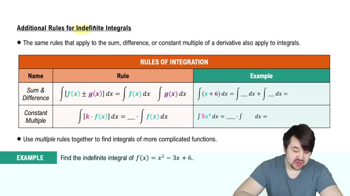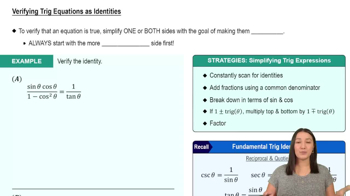Apply the formula for cos (A − B) to the identity sin θ = cos (π/2 − θ) to obtain the addition formula for sin (A + B).
Table of contents
- 0. Functions7h 54m
- Introduction to Functions16m
- Piecewise Functions10m
- Properties of Functions9m
- Common Functions1h 8m
- Transformations5m
- Combining Functions27m
- Exponent rules32m
- Exponential Functions28m
- Logarithmic Functions24m
- Properties of Logarithms36m
- Exponential & Logarithmic Equations35m
- Introduction to Trigonometric Functions38m
- Graphs of Trigonometric Functions44m
- Trigonometric Identities47m
- Inverse Trigonometric Functions48m
- 1. Limits and Continuity2h 2m
- 2. Intro to Derivatives1h 33m
- 3. Techniques of Differentiation3h 18m
- 4. Applications of Derivatives2h 38m
- 5. Graphical Applications of Derivatives6h 2m
- 6. Derivatives of Inverse, Exponential, & Logarithmic Functions2h 37m
- 7. Antiderivatives & Indefinite Integrals1h 26m
- 8. Definite Integrals4h 44m
- 9. Graphical Applications of Integrals2h 27m
- 10. Physics Applications of Integrals 3h 16m
- 11. Integrals of Inverse, Exponential, & Logarithmic Functions2h 31m
- 12. Techniques of Integration7h 41m
- 13. Intro to Differential Equations2h 55m
- 14. Sequences & Series5h 36m
- 15. Power Series2h 19m
- 16. Parametric Equations & Polar Coordinates7h 58m
0. Functions
Trigonometric Identities
Problem 1.3.36
Textbook Question
Using the Addition Formulas
Use the addition formulas to derive the identities in Exercises 31–36.
sin (A − B) = sin A cos B − cos A sin B
 Verified step by step guidance
Verified step by step guidance1
Start by recalling the addition formula for sine, which is: .
To derive the formula for , use the identity for sine of a negative angle: .
Apply the identity to the addition formula: .
Substitute into the addition formula: .
Use the identities and to simplify: .
 Verified video answer for a similar problem:
Verified video answer for a similar problem:This video solution was recommended by our tutors as helpful for the problem above
Video duration:
5mPlay a video:
Was this helpful?
Key Concepts
Here are the essential concepts you must grasp in order to answer the question correctly.
Addition Formulas
Addition formulas are trigonometric identities that express the sine and cosine of the sum or difference of two angles in terms of the sines and cosines of the individual angles. For example, the sine of the difference of two angles, sin(A - B), can be expressed as sin A cos B - cos A sin B. These formulas are essential for simplifying expressions and solving trigonometric equations.
Recommended video:

Additional Rules for Indefinite Integrals
Trigonometric Identities
Trigonometric identities are equations that hold true for all values of the variables involved, provided they are within the domain of the functions. They are fundamental in calculus and trigonometry for transforming and simplifying expressions. The addition formulas are a subset of these identities, allowing for the manipulation of sine and cosine functions in various mathematical contexts.
Recommended video:

Verifying Trig Equations as Identities
Derivation Techniques
Derivation techniques involve the methods used to prove or derive mathematical identities from established formulas. In the context of trigonometric identities, this often includes algebraic manipulation, substitution, and the application of known identities. Understanding these techniques is crucial for effectively deriving new identities, such as the sine and cosine addition formulas.
Recommended video:

Derivatives

 6:36m
6:36mWatch next
Master Simplifying Trig Expressions with a bite sized video explanation from Patrick
Start learningRelated Videos
Related Practice
Textbook Question
